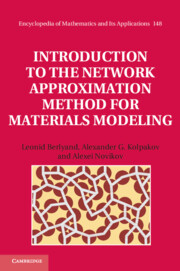Crossref Citations
This Book has been
cited by the following publications. This list is generated based on data provided by Crossref.
Filshtinsky, Leonid
and
Mityushev, Vladimir
2014.
Mathematics Without Boundaries.
p.
217.
Bryla, Marta
Krupoderov, Andrei V.
Kushunin, Alexey A.
Mityushev, Vladimir
and
Zhuravkov, Michail A.
2014.
Handbook of Functional Equations.
Vol. 95,
Issue. ,
p.
15.
Kang, Hyeonbae
Lee, Hyundae
and
Yun, KiHyun
2015.
Optimal estimates and asymptotics for the stress concentration between closely located stiff inclusions.
Mathematische Annalen,
Vol. 363,
Issue. 3-4,
p.
1281.
Rylko, Natalia
2015.
A PAIR OF PERFECTLY CONDUCTING DISKS IN AN EXTERNAL FIELD.
Mathematical Modelling and Analysis,
Vol. 20,
Issue. 2,
p.
273.
Kalamkarov, Alexander L.
Andrianov, Igor V.
Pacheco, Pedro M. C. L.
Savi, Marcelo A.
and
Starushenko, Galina A.
2016.
Asymptotic Analysis of Fiber-Reinforced Composites of Hexagonal Structure.
Journal of Multiscale Modelling,
Vol. 07,
Issue. 03,
p.
1650006.
Farah, Yahya
Loghin, Daniel
Tzella, Alexandra
and
Vanneste, Jacques
2020.
Diffusion in arrays of obstacles: beyond homogenization.
Proceedings of the Royal Society A: Mathematical, Physical and Engineering Sciences,
Vol. 476,
Issue. 2244,
Mityushev, Vladimir
and
Zhunussova, Zhanat
2021.
Optimal Random Packing of Spheres and Extremal Effective Conductivity.
Symmetry,
Vol. 13,
Issue. 6,
p.
1063.
Rylko, Natalia
and
Tytko, Karolina
2022.
Current Trends in Analysis, its Applications and Computation.
p.
297.
Gérard-Varet, David
and
Girodroux-Lavigne, Alexandre
2022.
Homogenization of stiff inclusions through network approximation.
Networks and Heterogeneous Media,
Vol. 17,
Issue. 2,
p.
163.
Kolpakov, Alexander G.
and
Rakin, Sergei I.
2023.
Numerical Construction of the Homogenized Strength Criterion for Fiber-Reinforced Composite.
Journal of Composites Science,
Vol. 7,
Issue. 4,
p.
145.
Iglesias‐Rodríguez, Ernesto
Bravo‐Castillero, Julián
Cruz, Manuel E.
and
Guinovart‐Díaz, Raúl
2023.
Conductivity gain predictions for multiscale fibrous composites with interfacial thermal barrier resistance.
Mathematical Methods in the Applied Sciences,
Vol. 46,
Issue. 6,
p.
6613.
Mityushev, Vladimir
Drygaś, Piotr
Gluzman, Simon
Nauryzbayev, Nurlan
and
Nurtazina, Karlygash
2025.
Computational Strategy for Analyzing Effective Properties of Random Composites—Part I: Conductivity.
Applied Sciences,
Vol. 15,
Issue. 7,
p.
3861.



